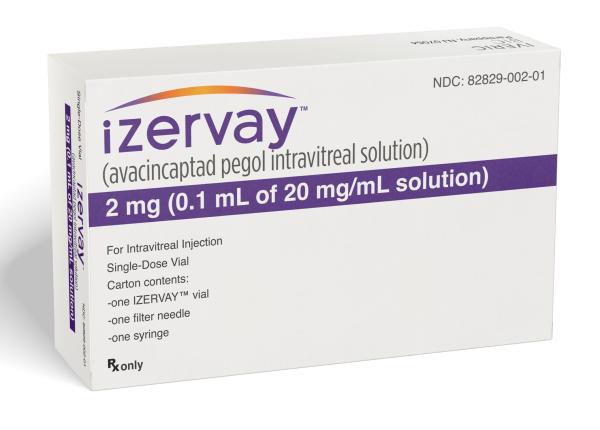Izervay Side Effects
Generic name: avacincaptad pegol ophthalmic
Medically reviewed by Drugs.com. Last updated on Nov 28, 2024.
Note: This document provides detailed information about Izervay Side Effects associated with avacincaptad pegol ophthalmic. Some dosage forms listed on this page may not apply specifically to the brand name Izervay.
Applies to avacincaptad pegol ophthalmic: intraocular solution.
Precautions
Your eye doctor will want to check your progress closely and at regular visits, especially during the first few days after you receive this medicine, to make sure this medicine is working properly and to check for unwanted effects.
Serious eye or vision problems (eg, retinal detachment, endophthalmitis, eye infection, increased pressure inside the eye, or neovascular AMD) may occur with this medicine. Check with your eye doctor right away if your have blurred or other change in vision, eye pain, eye redness, headache, seeing flashes or sparks of light, seeing floating spots before the eyes, or a veil or curtain appearing across part of vision, tearing of the eyes several days after you receive this medicine.
This medicine may cause temporary blurred vision. Do not drive or do anything else that could be dangerous until you can see clearly.
Serious side effects of Izervay
Along with its needed effects, avacincaptad pegol ophthalmic (the active ingredient contained in Izervay) may cause some unwanted effects. Although not all of these side effects may occur, if they do occur they may need medical attention.
Check with your doctor or nurse immediately if any of the following side effects occur while taking avacincaptad pegol ophthalmic:
More common side effects
- bloody eye
- blurred vision
- change in vision
- loss of vision
- redness of the eye
Less common side effects
- decrease in vision
- eye pain
- redness, swelling, or itching of the eyelid
- seeing floating dark spots or material before the eyes
Incidence not known
- seeing flashes or sparks of light
- seeing floating spots before the eyes, or a veil or curtain appearing across part of vision
- tearing of the eyes
See also:
For healthcare professionals
Applies to avacincaptad pegol ophthalmic: intravitreal solution.
General adverse events
The most frequently reported side effects included conjunctival hemorrhage (13%), increased intraocular pressure (IOP) (9%), blurred vision (8%) and neovascular age-related macular degeneration (7%).[Ref]
Ocular
- Very common (10% or more): Conjunctival hemorrhage (13%)
- Common (1% to 10%): Increased intraocular pressure, blurred vision, choroidal neovascularization, eye pain, vitreous floaters, blepharitis
- Frequency not reported: Ocular infection, periocular infection, active intraocular inflammation, endophthalmitis, retinal detachments, neovascular AMD[Ref]
Blurred vision includes visual impairment, blurred vision, reduced visual acuity, and transiently reduced visual acuity.[Ref]
References
1. (2023) "Product Information. Izervay (avacincaptad pegol ophthalmic)." IVERIC Bio, Inc.
Frequently asked questions
More about Izervay (avacincaptad pegol ophthalmic)
- Compare alternatives
- Pricing & coupons
- Reviews (4)
- Drug images
- Dosage information
- During pregnancy
- FDA approval history
- Drug class: anti-angiogenic ophthalmic agents
- Breastfeeding
- En español
Patient resources
Professional resources
Related treatment guides
Further information
Izervay side effects can vary depending on the individual. Always consult your healthcare provider to ensure the information displayed on this page applies to your personal circumstances.
Note: Medication side effects may be underreported. If you are experiencing side effects that are not listed, submit a report to the FDA by following this guide.

